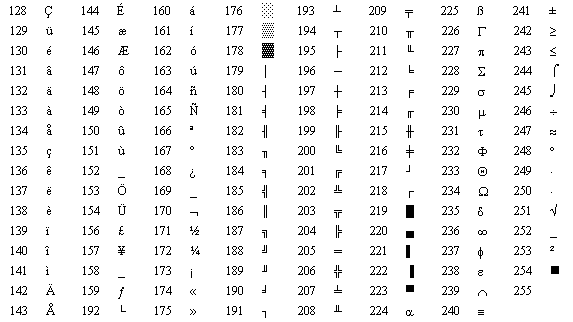- Tech Corner
- References
- Characters Ref
Characters Reference
ASCII
The American Standards Association (ASA), which later changed its name to the American National Standards Institute (ANSI), created the American Standard Code for Information Interchange (ASCII) in response to the need for a standard character code for interchanging data between systems. It decided that a 7-bit code (128 characters) would be sufficient for ASCII; 32 non-printable control characters, and 96 printing characters covering the full set of an English-language typewriter.
| ACK | Acknowledge | EM | End of medium | NUL | Null | ||
| BEL | Bell | ENQ | Enquiry | RS | Record separator | ||
| BS | Backspace | EOT | End of transmission | SI | Shift in | ||
| CAN | Cancel | ESC | Escape | SO | Shift out | ||
| CR | Carriage return | ETB | End of transmission block | SOH | Start of header | ||
| DC1 | Data control 1 | ETX | End of text | STX | Start of text | ||
| DC2 | Data control 2 | FF | NP form feed, new page | SUB | Substitute | ||
| DC3 | Data control 3 | FS | File separator | SYN | Synchronous idle | ||
| DC4 | Data control 4 | GS | Group separator | TAB | Horizontal tabulation | ||
| DEL | Delete | LF | NL Line feed, new line | US | Unit separator | ||
| DLE | Data link escape | NAK | Negative acknowledge | VT | Vertical tab |
Extended ASCII
The extended ASCII, a superset of ASCII, uses 8-bit to encode the characters. The extra bit gives an additional of 128 characters (shown in table 2 below) to the original ASCII. It allows text-based programs to draw boxes and mathematical symbols
 Table 2 - Extended ASCII codes.
Table 2 - Extended ASCII codes.
ISO Latin-1
The ISO 8859-1, also known as Latin-1, is a standard character set developed by the International Organization for Standardization (ISO). It extends ASCII to include Latin-languages letters. Latin-1 is one of the set of character entity references supported by HTML. This means that non-ASCII latin-based scripts may be represented on a web page by ISO Latin-1 codes. The first 128 Latin-1 characters being the same as ASCII, table 3 below shows the "upper" 128 characters.
Copyright © 2004, Northwest Summit. All rights reserved.